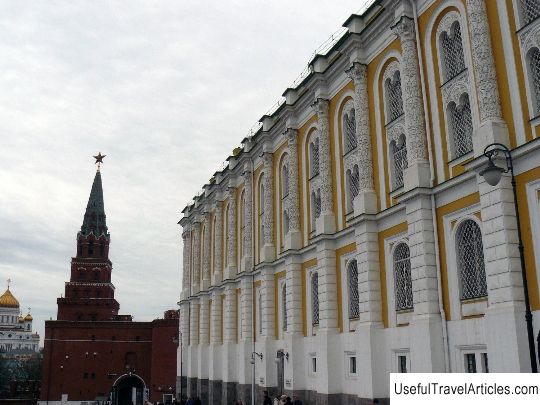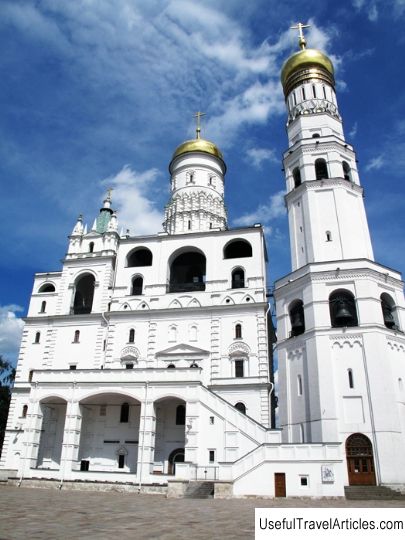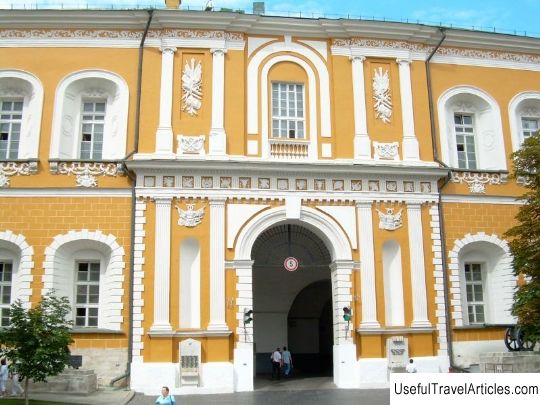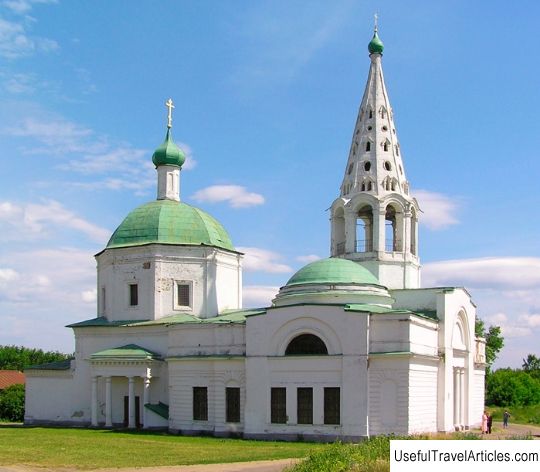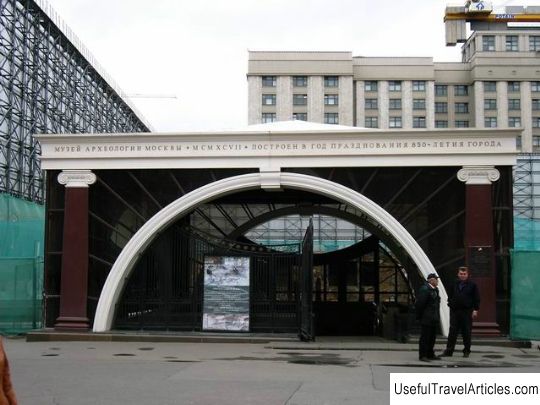The Armory Chamber of the Moscow Kremlin description and photo - Russia - Moscow: Moscow
Rating: 7,9/10 (786 votes) 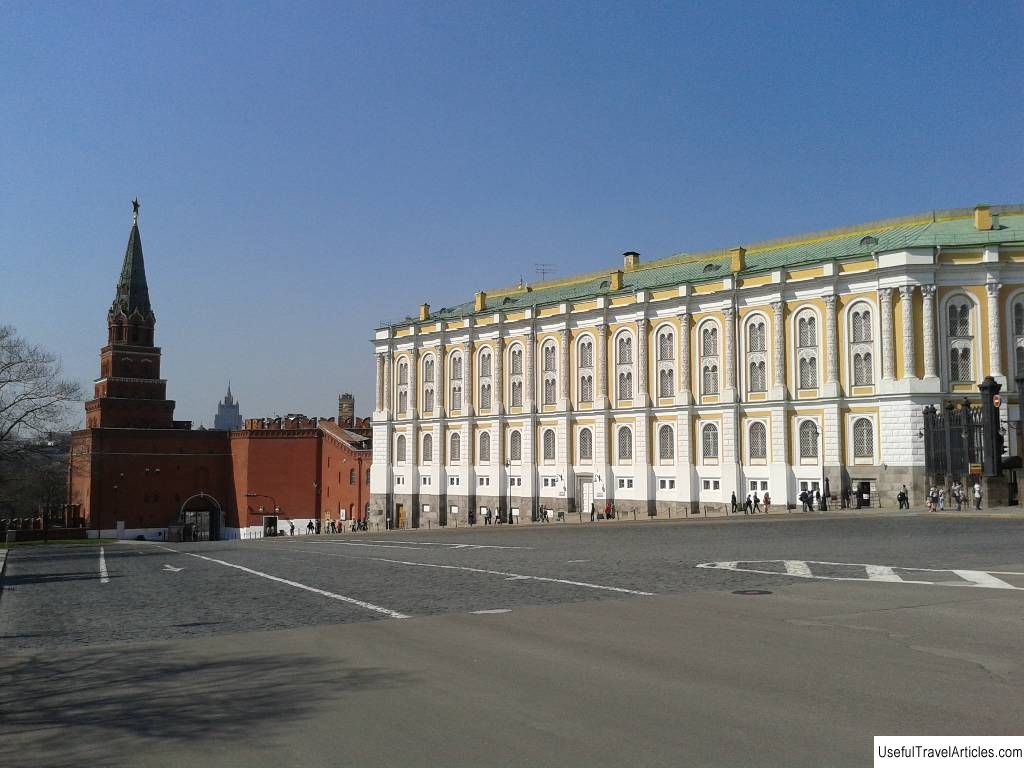
The Armory Chamber of the Moscow Kremlin description and photos - Russia - Moscow: Moscow. Detailed information about the attraction. Description, photos and a map showing the nearest significant objects. Photo and descriptionOne of the richest museums in Russia and the world, the Armory is named after the state treasury. Within its walls were kept treasures of the great Moscow princes and tsars , and later also gold reserves of the cathedrals of the Moscow Kremlin . The Armory became a museum in 1918, and today its collection includes more than 4000 items. The treasures of the Armory are dated from the 12th to the 19th centuries. From the depths of centuriesThe formation of the museum's collection took several centuries. The beginning of its creation is considered to be the XIV century, when the private treasury of the great Moscow princes, and then the tsars, began to grow rapidly. The expansion of the treasury was due to the annexation of more and more territories, occurred as a result of successful military campaigns. In 1484, in order to preserve the treasury values, it was decided to erect a separate building . For construction, a place was chosen between the Annunciation and Archangel Cathedrals on the territory of the Moscow Kremlin. All valuables were transported to the mansion, which ceased to be personal treasures, but, on the contrary, turned into the state treasury. The institution received the status of the Treasury. The treasury continued to replenish due to the expansion of new territories . In the conquered cities and principalities, treasures were confiscated, foreign ambassadors brought numerous gifts to the Kremlin, and expensive property was simply taken away from the disgraced boyars. Items from the treasury of the Treasury Court, starting from the 15th century, widely used at various ceremonies of the royal court. They were taken out of storage on the days of royal weddings and funerals, during receptions and weddings to the kingdom. The treasury was actively replenished with the help of the Moscow Kremlin workshops, which were called "chambers" . Armourers occupied the upper floors of a stone building near the Kremlin's Trinity Gate. In the Armory of the 15th-16th centuries, tsarist weapons were kept, and armor for the army was also made there. In the middle of the 17th century, the centralization of the Russian state facilitated the influx of masters from the provinces into the capital. Craftsmen from Suzdal, Vladimir, Novgorod and Murom began to work in the Armory. Kazan and Veliky Ustyug gunsmiths arrived, and Alexei Romanov pursued a policy of restructuring the army in the manner of a European one. The heads of the Armory during these years were significant boyars, who were also involved in providing the army with everything necessary. History of the museum Tsar Peter I ordered the creation of a single department" Workshop and Armory "in 1720, for which he united several services and institutions: - Tsaritsyn's workshop chamber - an order that existed until 1720, which was in charge of the treasurer-boyaryn. The order was in charge of the dresses of the queen and her children. Suppliers of paintings to the royal court were subordinate to the tsarina's workshop. - Treasury , where a lot of valuables had been collected by that time. - Treasury of the stable order , which was in charge of the equestrian business of the Russian state and everything that was somehow connected with horses. The stable order controlled herds and royal grooms, as well as estates where horses were kept. The order was in charge of the treasury, which consisted of precious horse headwear, carriages and carriages. A considerable contribution to the stable treasury was made by taxes, which were required to be paid when buying and selling horses. The chief equestrian actively participated in the military and even diplomatic affairs of the state and actually commanded the Boyar Duma. The most famous head of the Stables Office in the history of the Russian state is B.F. Godunov, who became tsar in 1598. - Treasury of the Patriarchal Chamber and Churches , located on the territory of the Kremlin. The newly created department was named "Workshop and Armory" and was transferred to the jurisdiction of the Senate. From that moment on, any withdrawal of items from the collection of the chamber is impossible. In 1728, the Armory became only a repository of artistic and historical values. In 1807, by order of Emperor Alexander I , a building was built on Senate Square in the Moscow Kremlin. The collection of treasures was moved there, but the unsuitable conditions for storing the exhibits made it necessary to build another room. In 1849, the architect Konstantin Ton proposed his own project, and the construction of a new building began on the site where the Konyushenny Prikaz was located. The Armory building Construction work lasted about two years and was completed in 1851 . The Armory was now part of the Grand Kremlin Palace complex and was a Russian-Byzantine house with a high plinth. Its outline resembled the former Konyushenny order. The building was decorated in full accordance with the architectural fashion of the mid-19th century. Platbands with weights, carved white stone columns, pilasters and marble medallions with portraits of emperors and grand dukes were used as decorative elements. The stone images were made by Fedot Shubin - the most significant representative of sculptural sentimentalism of the 18th century in Russia. Initially, the images were in the Chesme Palace, abandoned during the reign of Paul I. Later, the portraits were transferred to decorate the facades of the newly built Armory. The author of the cast-iron lattice separating the chamber from the Grand Kremlin Palace is the brightest representative of the architectural trend Russian pseudo-Gothic Ivan Mironovsky. From the Soviets to the present day After the 1917 revolution, the chamber was turned into a museum by a special decree of the new government. His collection was quickly replenished with valuables confiscated from noble estates and nationalized treasures from monasteries and churches. The museum offered to get acquainted with the exposition, through which the theme of centuries-old exploitation of serfs and workers ran like a red thread. In the 30s of the last century, the collection of the museum was partially plundered under the pretext of confiscation of the storage items by the Gokhran commission. A group of people calling themselves "Antiques" and using the documents of the Gokhran, withdrew more than three hundred items from the exposition and sold them to private individuals. The list of the missing included, among other things, eleven Easter eggs made by jewelers from the workshop of Carl Faberge . Not long before that, the director of the museum, writer and art critic D. Ivanov committed suicide, not wanting to put up with the plundering of the country's historical and cultural heritage. In our time, restoration work is underway in the premises of the shopping arcade on Red Square, granted to the Armory Chamber by decree of the Moscow government. After the repair is completed, part of the museum's exposition will open in them. What to see in the Armory The museum exposition is divided into several thematic sections and is located in nine rooms. Among the collections are presented not only weapons and jewelry, but also items of ceremonial ceremonies, royal regalia, equestrian decoration and even carriages. The most significant and well-known exhibits of the Armory Chamber: - Armor and helmets, as well as samples of Russian and foreign weapons . The museum displays the helmet of the father of Alexander Nevsky, Prince Yaroslav Vsevolodovich; the pointed helmet of Tsarevich Ivan, son of Ivan the Terrible; chain mail of the participant of the Kazan campaigns Pyotr Shuisky, presented to Ermak; shields made in the XII-XVII centuries; ceremonial armor of Alexey and Mikhail Romanov; edged weapons of various types and purposes. - The gold and silver fund of the Armory is represented by items made by craftsmen in the period from the 12th to the 17th century. Particularly ancient exhibits are items from the Staroryazan treasure found in the 19th century, made in the technique of cloisonne enamel and filigree and dating from the 12th-13th centuries. - Yuri Dolgoruky's chalice in 1152 was laid in the foundation during the construction of the Transfiguration Cathedral in Pereslavl-Zalessky. Later, the relic ended up in the Armory. - XIV-XV centuries are presented in the museum by the works of Vladimir and Suzdal masters. Particularly valuable relics of that era are the Ark of Dionysius , commissioned by Prince Dmitry Konstantinovich and made of silver and precious stones, and Morozov's Gospel of the Assumption Cathedral . - Famous Monomakh's hat was made in the XIII-XIV centuries by unknown oriental masters. The oldest hereditary object of the museum, Monomakh's hat was considered a symbol of autocracy in Russia. The golden filigree crown for Ivan the Terrible, presented to him in honor of the annexation of the Kazan Khanate, is called Kazan Hat and is also exhibited among the products of Kremlin craftsmen. - St. Petersburg School of Silver , which received special development in the 18th century, is represented in the Armory Chamber by numerous items for table setting. Among others, the silver dish presented by Catherine II to Grigory Potemkin is worthy of special attention. - Foreign gifts presented to Russian ambassadors and deposited in the Armory are made of exotic and unusual for Russia materials. The exposition includes the Iranian throne, faced with gold and inlaid with turquoise - a gift to Boris Godunov from the Iranian shah. - Coronation outfits of Russian tsars and empresses are exhibited in the hall dedicated to fabrics and sewing XIV -XVIII centuries. Here you can also see the clothes of the metropolitans, woven from Byzantine atlas. Their dress was decorated with precious stones and gold embroidery. - The first craftsmen who made carriages appeared in Russia in the 18th century, but already from the 16th century, carriages were purchased in Europe and used at the royal court. The oldest piece of the carriage collection of the Armory was made in England in the 16th century. The crew was presented to Boris Godunov during his coronation. The carriage is decorated with inlays, carvings and paintings. - products of the famous Faberge jewelry company deserve special attention. In the Armory, you can see the famous Easter egg presented by Emperor Nicholas II to Alexandra Fedorovna and decorated with a map of the Russian state with the Trans-Siberian Railway laid on it. The precious egg contains a surprise in the form of a miniature replica of a train. Carl Faberge's workshop also owned the idea of the "Pansies" flower, made for Nicholas II and presented by the emperor to his wife for the tenth wedding anniversary. Dmitry Likhachev, academician and writer, called the Armory "the materialized memory of our people and the treasury of Russia."      We also recommend reading Place des Vosges description and photos - France: Paris Topic: The Armory Chamber of the Moscow Kremlin description and photo - Russia - Moscow: Moscow. |

